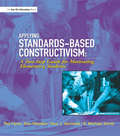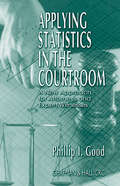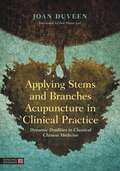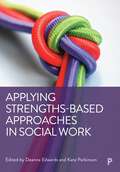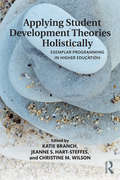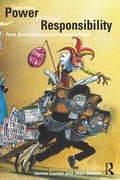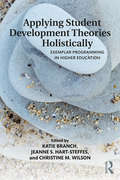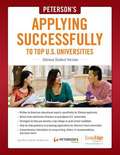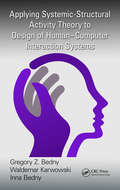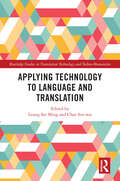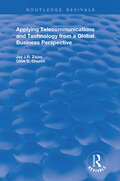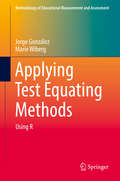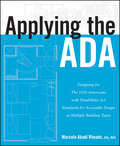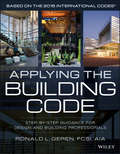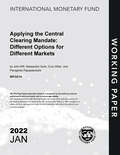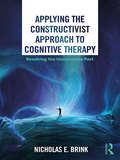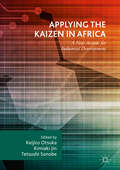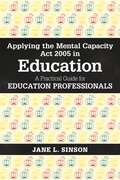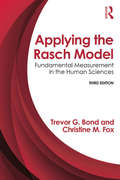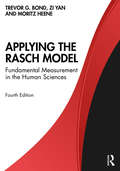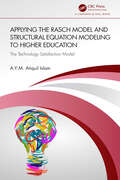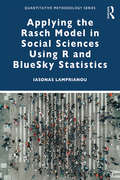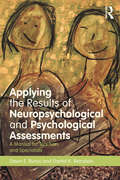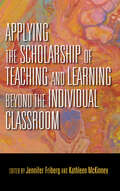- Table View
- List View
Applying Standards-Based Constructivism: Elementary
by Paul Vermette Pat Flynn Don MesibovThis book provides teachers with practical ways of constructing lessons that will engage students and help them develop personal responsibility for their own learning.
Applying Statistics in the Courtroom: A New Approach for Attorneys and Expert Witnesses
by Philip GoodThis publication is directed at both attorneys and statisticians to ensure they will work together successfully on the application of statistics in the law. Attorneys will learn how best to utilize the statistician's talents, while gaining an enriched understanding of the law relevant to audits, jury selection, discrimination, environmental hazards, evidence, and torts as it relates to statistical issues. Statisticians will learn that the law is what judges say it is and to frame their arguments accordingly. This book will increase the effectiveness of both parties in presenting and attacking statistical arguments in the courtroom. Topics covered include sample and survey methods, probability, testing hypotheses, and multiple regression.
Applying Stems and Branches Acupuncture in Clinical Practice: Dynamic Dualities in Classical Chinese Medicine
by Joan DuveenClassical acupuncture according to the philosophy of the heavenly stems and earthly branches uses the fundamental, cyclical rhythms of nature and life as a foundation for health and development. This book is one of the first of its kind in the western world to offer a practical and scholarly approach to applying this philosophy to clinical practice. This handbook guides the practitioner into a journey of better understanding of the self and provides the theoretical background to be able to confidently diagnose and treat patients. It offers invaluable insight into the use of Chinese philosophy, psychology and pulse diagnosis.
Applying Strengths-Based Approaches in Social Work
by Deanna Edwards and Kate ParkinsonThis textbook offers students and practitioners an accessible introduction to strengths-based approaches in Social Work and Social Care practice. Covering the theory and research in support of these approaches, and packed full of case studies, the book will allow readers to develop a critical understanding of how strengths-based approaches work, and how they can be successfully applied in order to improve outcomes for people with lived experience. Covering the five main models of strengths-based practice, the text presents international research and evidence on the efficacy of each approach, enabling students and practitioners to apply the benefits in their own social work practice. The guide features the perspectives of people with lived experience throughout and includes the following key learning features: • case studies of best practice; • points for practice: succinct tips for practitioners and students on practice placement; • further reading list and resources; • glossary.
Applying Student Development Theories Holistically: Exemplar Programming in Higher Education
by Katherine Branch Jeanne Hart-Steffes Christine WilsonThis book dives into student development theory, unpacking key foundational and emergent theories of college student development while providing contemporary examples and application. Showcasing a diversity of programs, practices, and services across a variety of institutional types, Applying Student Development Theories Holistically demonstrates how professionals are intertwining the science of theory with the art of practice in multidimensional, holistic ways. Helping aspiring higher education and student affairs practitioners grasp and use theories holistically, this important text brings to life theoretical knowledge to enhance the development and learning of college and university students.
Applying Student Development Theories Holistically: Exemplar Programming in Higher Education
by Christine Wilson Jeanne Hart-Steffes Katherine BranchThis book dives into student development theory, unpacking key foundational and emergent theories of college student development while providing contemporary examples and application. Helping aspiring higher education and student affairs practitioners grasp and use theories holistically, this important text brings to life theoretical knowledge to enhance the development and learning of college and university students. Showcasing a diversity of programs, practices, and services across a variety of institutional types, Applying Student Development Theories Holistically demonstrates how professionals are intertwining the science of theory with the art of practice in multidimensional, holistic ways.
Applying Student Development Theories Holistically: Exemplar Programming in Higher Education
by Christine Wilson Jeanne Hart-Steffes Katherine BranchThis book dives into student development theory, unpacking key foundational and emergent theories of college student development while providing contemporary examples and application. Helping aspiring higher education and student affairs practitioners grasp and use theories holistically, this important text brings to life theoretical knowledge to enhance the development and learning of college and university students. Showcasing a diversity of programs, practices, and services across a variety of institutional types, Applying Student Development Theories Holistically demonstrates how professionals are intertwining the science of theory with the art of practice in multidimensional, holistic ways.
Applying Successfully to Top US Universities
by Jason MorrisPeterson's Applying Successfully to Top U.S. Universities is a unique guide that assists highly ambitious Chinese students to get accepted to one of the top-ranked higher-education institutions in the United States, to both undergraduate and graduate programs of study. The book starts out with a general overview of what to expect from receiving a higher education in the United States, from earning a degree to financial aid, from campus life to the academic calendar. You will find an entire chapter dedicated to the rankings of schools and universities: who creates the rankings, how to read them, and what to do with the information provided by them. This book also offers extensive information about the language proficiency and admittance tests you may have to take and advice on how to handle the financial aspect of a U.S. education, with a list of scholarships and financial aid available. You will find valuable strategies for building a strong and successful application, with special emphasis on creating an outstanding essay or statement of purpose and securing strong letters of recommendation. The book concludes with extensive advice from admission officers and successful international students.
Applying Systemic-Structural Activity Theory to Design of Human-Computer Interaction Systems (Ergonomics Design & Mgmt. Theory & Applications)
by Gregory Z. Bedny Waldemar Karwowski Inna BednyHuman Computer Interaction (HCI) is no longer limited to trained software users. Today people interact with various devices such as mobile phones, tablets, and laptops. How can such interaction be made more user friendly, even when user proficiency levels vary? This book explores methods for assessing the psychological complexity of compute
Applying Systems Thinking to Regenerative Medicine: Proceedings of a Workshop
by Health and Medicine Division Board on Health Sciences Policy Forum on Regenerative MedicineRegenerative medicine products, which are intended to repair or replace damaged cells or tissues in the body, include a range of therapeutic approaches such as cell- and gene-based therapies, engineered tissues, and non-biologic constructs. The current approach to characterizing the quality of a regenerative medicine product and the manufacturing process often involves measuring as many endpoints as possible, but this approach has proved to be inadequate and unsustainable. The Forum on Regenerative Medicine of the National Academies of Sciences, Engineering, and Medicine convened experts across disciplines for a 2-day virtual public workshop to explore systems thinking approaches and how they may be applied to support the identification of relevant quality attributes that can help in the optimization of manufacturing and streamline regulatory processes for regenerative medicine. A broad array of stakeholders, including data scientists, physical scientists, industry researchers, regulatory officials, clinicians, and patient representatives, discussed new advances in data acquisition, data analysis and theoretical frameworks, and how systems approaches can be applied to the development of regenerative medicine products that can address the unmet needs of patients. This publication summarizes the presentation and discussion of the workshop.
Applying Technology to Language and Translation (Routledge Studies in Translation Technology)
by Leung Sze Ming and Chan Sin-waiA cutting-edge collection of work on the influence and application of new technologies on the study and practice of language and translation. This book analyzes the relationship between technology, language, and translation in the digital age. Language issues covered include an automatic football commentary system, the use of digital humanities in the versification of Classical Chinese poetry, the application of corpus linguistics in identity construction in Hong Kong, Cantonese speech recognition, and the use of AI in a Chabot system. Other chapters look at translation matters, such as technologies for interpreting, neural machine translation for press releases, computer-aided annotation for translator and interpreter training, and artificial intelligence and translation. As language and translation are closely intertwined, together, these chapters illustrate the drastic changes that technology has brought to these combined areas. A vital resource for scholars and students studying the impact of technology on language and translation.
Applying Telecommunications and Technology from a Global Business Perspective
by Jay J. ZajasAn exploration of the changes and developments in telecommunications over a span of fifty years by a business person and then Professor Emeritus, reflecting on the many changes that have taken place from when the word " telecommunications" did not exist. Two decades ago, his life in academia included no personal computer or any other desk in the Business Administration Department, and when the first fax machine came, it was hard to believe that a perfect copy of a proposed paper could be received by a long time co-author in Turku, Finland in minutes. First published in 1997, when e-mail and the Internet were still new to most people on campus.
Applying Test Equating Methods: Using R (Methodology of Educational Measurement and Assessment)
by Marie Wiberg Jorge GonzálezThis book describes how to use test equating methods in practice. The non-commercial software R is used throughout the book to illustrate how to perform different equating methods when scores data are collected under different data collection designs, such as equivalent groups design, single group design, counterbalanced design and non equivalent groups with anchor test design. The R packages equate, kequate and SNSequate, among others, are used to practically illustrate the different methods, while simulated and real data sets illustrate how the methods are conducted with the program R. The book covers traditional equating methods including, mean and linear equating, frequency estimation equating and chain equating, as well as modern equating methods such as kernel equating, local equating and combinations of these. It also offers chapters on observed and true score item response theory equating and discusses recent developments within the equating field. More specifically it covers the issue of including covariates within the equating process, the use of different kernels and ways of selecting bandwidths in kernel equating, and the Bayesian nonparametric estimation of equating functions. It also illustrates how to evaluate equating in practice using simulation and different equating specific measures such as the standard error of equating, percent relative error, different that matters and others.
Applying the ADA
by Marcela A. RhoadsA guide to real-world applications of The 2010 Americans with Disabilities Act Standards for Accessible DesignApplying the ADA helps architects and developers understand better how the rules for eliminating barriers in the built environment apply to everyday life and how to best implement them in the design and construction of a broad variety of buildings and facilities.By showing how The 2010 Americans with Disabilities Act Standards for Accessible Design have been applied in various contexts and building types, this extensively illustrated guide helps readers quickly understand the requirements of the standards and how to apply them to both new construction and renovation. Written by an architect who consults regularly on accessibility issues for design professionals, building owners, and facility managers, this user-friendly guide features 100 photos and 150 drawings that take the guesswork out of applying the standards to real-world projects. Building types covered include:Healthcare and senior living facilities and hospitalsCollege and university facilitiesElementary and high schoolsHotels and other transient lodging facilitiesAmusement parks and play areasHistoric preservation and remodelsRetail and office spacesApplying the ADA is an indispensable resource for architects, interior designers, owners, developers, and facility managers. It is also important reading for students of architecture and interior design.
Applying the Building Code
by Ronald L. GerenNo other resource--not even the building code--presents the exact code information you need, when you need it at design stage The International Building Code (IBC) is a model building code developed by the International Code Council (ICC). The IBC and its complementary codes provide design and construction professionals with a complete set of comprehensive, coordinated building safety and fire prevention regulations in order to safeguard the public health and general welfare of the occupants of new and existing buildings and structures. Adopted throughout most of the United States and its territories, it is referenced by federal agencies, such as the General Services Administration, National Park Service, Department of State, U.S. Forest Service, and the Department of Defense. For architects and other design and construction professionals, it is particularly important that they understand how to apply the IBC and how code officials view buildings, so that they integrate code-required provisions in the earliest design stages of any project. Applying the IBC, as well as its companion codes, to building design is a process that is uniquely different to that of applying the building code during a planning review. Whereas other guide books explain the IBC in sequential order, from cover to cover, chapter by chapter, and section by section, Applying the Building Code explains the requirements of the IBC as they would apply during the common phases of design: from schematic design through to the preparation of construction documents. This effectively highlights applicable requirements of the building code at the appropriate stage of design based on available information. The book provides a 28-step process that is organized according to the three phases of architectural design: schematic design, design development, and construction documents Each step explains the application of the IBC, as well as other codes and standards referenced by the IBC (i.e. International Fire Code, International Energy Conservation Code, and ANSI A117.1) based on available project information Illustrations and examples are provided throughout that explain the code fundamentals associated with each step A single example project is used throughout the step-by-step process to illustrate how each step is applied and builds upon code and project information obtained through previous steps Guidance is also provided on the International Existing Building Code and how the step-by-step process is applied to projects involving existing buildings The role of the building department and its staff in regard to plan reviews and code enforcement is discussed A detailed code data information template is provided that can help organize code-related information for construction documents
Applying the Central Clearing Mandate: Different Options for Different Markets (Imf Working Papers)
by John Kiff, Alessandro Gullo, Cory Hillier, and Panagiotis PapapaschalisA report from the International Monetary Fund.
Applying the Constructivist Approach to Cognitive Therapy: Resolving the Unconscious Past
by Nicholas E. BrinkApplying the Constructivist Approach to Cognitive Therapy goes beyond the traditional objectivist approach of uncovering the what of a client’s dysfunctional thinking by helping client and therapist understand why the client thinks in a dysfunctional manner. This unique work demonstrates how this thinking can be uncovered through dreamwork, analytic hypnotherapy, ecstatic trance, and other spontaneous trance experiences such as the use of imagination, free association, and guided imagery. Utilizing hypnotherapeutic techniques, the author shows how clients can reframe these thoughts to achieve a healthier, more functional way of thinking. Replete with case studies and practical guidance, this text will help therapists take clients beyond a simple resolution of their problems and offer an avenue to greater personal growth, maturity, and creativity.
Applying the Kaizen in Africa: A New Avenue for Industrial Development
by Keijiro Otsuka Kimiaki Jin Tetsushi SonobeAt present, how to develop industries is a burning issue in Africa, where population growth remains high and economic development has thus far failed to provide sufficient jobs for many, especially young people and women. The creation of productive jobs through industrial development ought to be a central issue in steering economic activity across the continent.The authors of this book, consisting of two development economists and five practitioners, argue that the adoption of Kaizen management practices, which originated in Japan and have become widely used by manufacturers in advanced and emerging economies, is decisively the most effective first step for industrial development in Africa.This open access book discusses what Kaizen management is, why it is applicable to Africa, and why it can provide Africa with a springboard for sustainable economic growth and employment generation.
Applying the Mental Capacity Act 2005 in Education: A Practical Guide for Education Professionals
by Jane L. SinsonThis straightforward book explains the introduction of the Mental Capacity Act 2005 (MCA) and its code of practice (COP) as part of the Children and Families Act 2014 and the accompanying SEND COP in England. This is the first comprehensive book to explain to education professionals the legal requirement to follow the MCA COP and SEND COP guidelines when formally considering a young person's (16 - 25) capacity to make decisions about their education. Using education-focussed case studies throughout to illustrate key points, this practical guide explains the MCA five principles, defines the term 'mental capacity' and clarifies the circumstances in which a young person would lack capacity to make a decision. It describes when a capacity assessment is likely to be required and presents a step-by-step guide to undertaking a capacity assessment. This is the essential guide to the MCA for FE college tutors, post 16 teachers, specialist teachers, local authority SEN officers and educational psychologists.
Applying the Rasch Model: Fundamental Measurement in the Human Sciences, Third Edition
by Trevor Bond Christine M. FoxCited over 1900 times, this classic text facilitates a deep understanding of the Rasch model. The authors review the crucial properties of the model and demonstrate its use with a variety of examples from education, psychology, and health. A glossary and numerous illustrations aid the reader's understanding. Readers learn how to apply Rasch analysis so they can perform their own analyses and interpret the results. The authors present an accessible overview that does not require a mathematical background. Highlights of the new edition include: -More learning tools to strengthen readers’ understanding including chapter introductions, boldfaced key terms, chapter summaries, activities, and suggested readings. -Divided chapters (4, 6, 7 & 8) into basic and extended understanding sections so readers can select the level most appropriate for their needs and to provide more in-depth investigations of key topics. -A website at www.routledge.com/9780415833424 that features free Rasch software, data sets, an Invariance worksheet, detailed instructions for key analyses, and links to related sources. -Greater emphasis on the role of Rasch measurement as a priori in the construction of scales and its use post hoc to reveal the extent to which interval scale measurement is instantiated in existing data sets. -Emphasizes the importance of interval level measurement data and demonstrates how Rasch measurement is used to examine measurement invariance. -Insights from other Rasch scholars via innovative applications (Ch. 9). -Extended discussion of invariance now reviews DIF, DPF, and anchoring (ch. 5). -Revised Rating Scale Model material now based on the analysis of the CEAQ (ch.6). -Clarifies the relationships between Rasch measurement, True Score Theory, and Item Response Theory by reviewing their commonalities and differences (Ch.13). -Provides more detail on how to conduct a Rasch analysis so readers can use the techniques on their own (Appendix B). Intended as a text for graduate courses in measurement, item response theory, (advanced) research methods or quantitative analysis taught in psychology, education, human development, business, and other social and health sciences, professionals in these areas also appreciate the book‘s accessible introduction.
Applying the Rasch Model: Fundamental Measurement in the Human Sciences
by Trevor Bond Zi Yan Moritz HeeneRecognised as the most influential publication in the field, ARM facilitates deep understanding of the Rasch model and its practical applications. The authors review the crucial properties of the model and demonstrate its use with examples across the human sciences. Readers will be able to understand and critically evaluate Rasch measurement research, perform their own Rasch analyses and interpret their results. The glossary and illustrations support that understanding, and the accessible approach means that it is ideal for readers without a mathematical background. Highlights of the new edition include: More learning tools to strengthen readers’ understanding including chapter introductions, boldfaced key terms, chapter summaries, activities and suggested readings. Greater emphasis on the use of R packages; readers can download the R code from the Routledge website. Explores the distinction between numerical values, quantity and units, to understand the measurement and the role of the Rasch logit scale (Chapter 4). A new four-option data set from the IASQ (Instrumental Attitude towards Self-assessment Questionnaire) for the Rating Scale Model (RSM) analysis exemplar (Chapter 6). Clarifies the relationship between Rasch measurement, path analysis and SEM, with a host of new examples of Rasch measurement applied across health sciences, education and psychology (Chapter 10). Intended as a text for graduate courses in measurement, item response theory, (advanced) research methods or quantitative analysis taught in psychology, education, human development, business, and other social and health sciences. Professionals in these areas will also appreciate the book’s accessible introduction.
Applying the Rasch Model and Structural Equation Modeling to Higher Education: The Technology Satisfaction Model
by A.Y.M. Atiquil IslamThis book introduces the fundamentals of the technology satisfaction model (TSM), supporting readers in applying the Rasch model and structural equation modeling (SEM) – a multivariate technique – to higher education (HE) research. User satisfaction is traditionally measured along a single dimension. However, the TSM includes digital technologies for teaching, learning and research across three dimensions: computer efficacy, perceived ease of use and perceived usefulness. Establishing relationships among these factors is a challenge. Although commonly used in psychology to trace relationships, Rasch and SEM approaches are rarely used in educational technology or library and information science. This book, therefore, shows that combining these two analytical tools offers researchers better options for measurement and generalisation in HE research. This title presents theoretical and methodological insights of use to researchers in HE.
Applying the Rasch Model in Social Sciences Using R (Quantitative Methodology Series)
by Iasonas LamprianouThis unique text provides a step-by-step beginner’s guide to applying the Rasch model in R, a probabilistic model used by researchers across the social sciences to measure unobservable ("latent") variables. Each chapter is devoted to one popular Rasch model, ranging from the least to the most complex. Through a freely available and user-friendly package, BlueSky Statistics, Lamprianou offers a range of options for presenting results, critically examines the strengths and weaknesses of applying the Rasch model in each instance, and suggests more effective methodologies where applicable. With a focus on simple software code which does not assume extensive mathematical knowledge, the reader is initially introduced to the so-called simple Rasch Model to construct a "political activism" variable out of a group of dichotomously scored questions. In subsequent chapters, the book covers everything from the Rating Scale to the Many-facets Rasch model. The final chapter even showcases a complete mock manuscript, demonstrating how a Rasch-based paper on the identification of online hate speech should look like. Combining theoretical rigor and real-world examples with empirical datasets from published papers, this book is essential reading for students and researchers alike who aspire to use Rasch models in their research.
Applying the Results of Neuropsychological and Psychological Assessments: A Manual for Teachers and Specialists
by Dawn E. Burau Daniel K. ReinsteinNeuropsychological and psychological evaluations in school settings are often rich in detail about a child’s cognitive, academic and emotional functions, and come with specific recommendations to support the child’s performance in school. However, there is often a gap between the assessment results and the implementation of the recommendations, since learning specialists and teachers frequently do not have the means to both interpret and implement the recommendations. This manual presents clear and specific guidelines for school counselors and teachers to decode and put into practice evaluation findings. The book begins by describing various functional domains that are assessed in a neuropsychological evaluation, and then notes how to recognize behavior and learning styles impacted by difficulty in one of more of the domains. Furthermore, it outlines activities that could be used in the classroom or other environments to support a child’s weaknesses, develop new skills, or appear to particular strengths. Finally, ready-to-use worksheets and activities are offered. This is an essential tool for school psychologists, special education teachers, and learning specialists and counselors.
Applying the Scholarship of Teaching and Learning beyond the Individual Classroom (Scholarship of Teaching and Learning)
by Edited by Jennifer Friberg and Kathleen McKinneyA survey of exemplary SoTL research projects and the use of their results on a broader scale.When the Scholarship of Teaching and Learning (SoTL) emerged, it often concentrated on individual faculty practice in one classroom; it is now, however, increasingly common to find work in SoTL focused more broadly. SoTL studies may engage with a cluster of courses, a program, a particular population of students, a pedagogical approach, or a field—all of which are represented in the essays collected here by authors from a diverse array of institutions and nations. This volume features examples of SoTL research conducted in, and applied to, a variety of contexts and disciplines, offering a theoretical framework for an expanded vision of SoTL—one that moves beyond the individual classroom.
